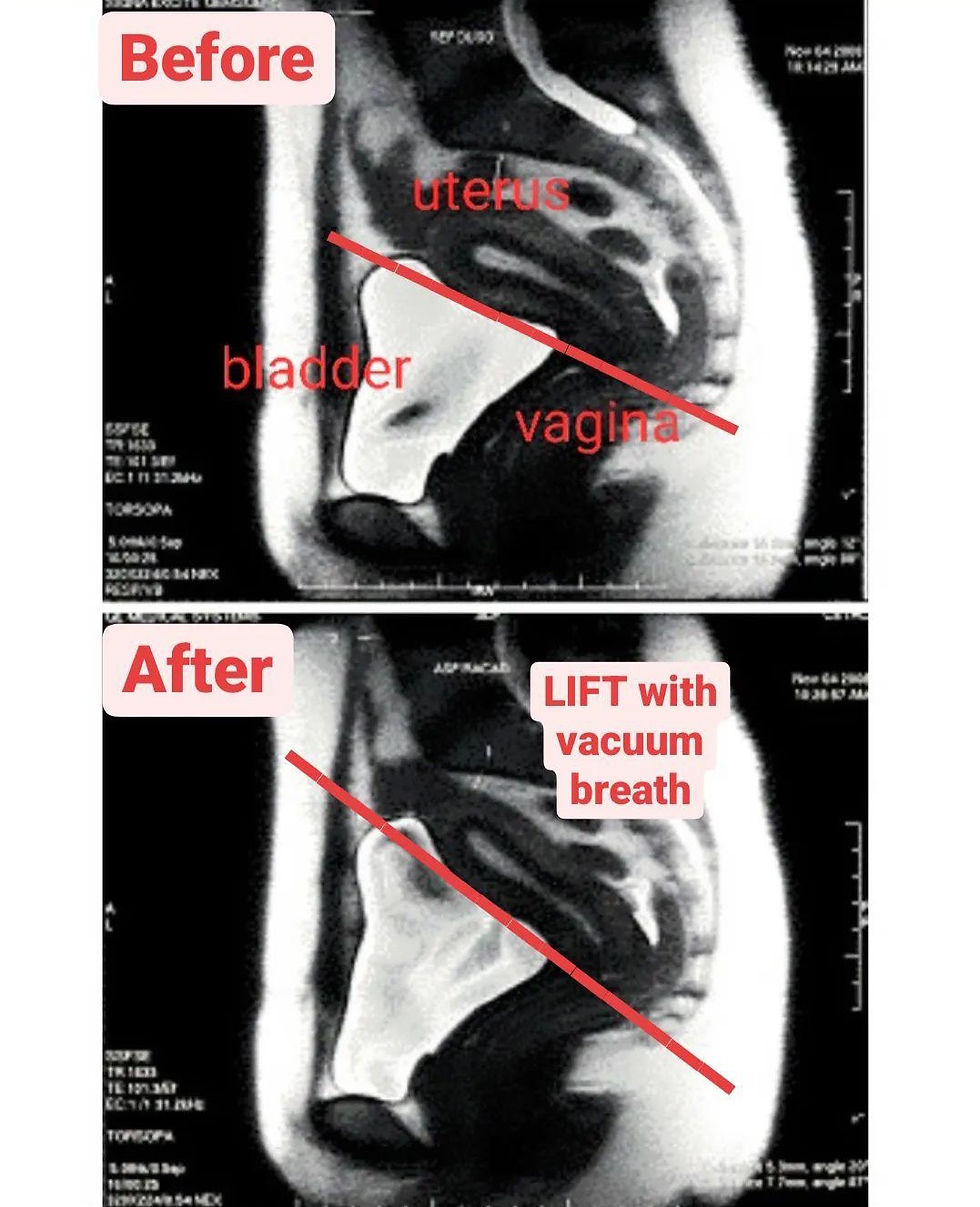Can Hypopressives Lift Prolapse?
- Alice Housman
- Jul 23, 2021
- 3 min read
Updated: Oct 22

If you're struggling to see improvements in your prolapse or leaking symptoms with pelvic floor exercises (Kegels), hypopressives are a safe and effective alternative to surgery, strengthening and toning the pelvic floor muscles.
Hypopressives can help correct the position of the prolapse and even help reduce the grade of the prolapse (see testimonials below).
Why are Hypopressives so great for prolapse and incontinence?
1) The Hypopressives vacuum is key to strengthening and toning the pelvic floor and you can read more here - What Are Hypopressives?
Hypopressives improves the strength and tone of the pelvic floor, helping you feel more supported, confident and in control. Many women describe a feeling of lightness and lift through a regular hypopressives practice.
These are some of the results our clients have seen through our 14-week hypopressives programme:
"My GP assessed me as having a grade 2 rectocele, today I've improve to a grade 1. My physio said keep doing whatever you're doing as it's working!"
- Susan
"I saw my physio today. I have gone from a 2 rectocele to a 1 and she says I don't have to go back unless I have any issues"
- Phoebe
"No signs of prolapse [cystocele] now - I've been checked by my physio!"
- Sarah
"I returned to my physio after 6 weeks of hypopressives. She was amazed and said the prolapse was 'barely there"
- Kayleigh
"I saw my physio last week and she said no rectocele anymore - whoop!"
- Anna
2) Hypopressives creates a physical lift of the pelvic organs.
When performed correctly, the bladder physically moves up and into a better position each time you do the a hypopressives vacuum breath. There is a ligament like structure called the median umbilical ligament that attaches from the apex of the bladder to the back of the abdominal wall behind your belly button. When the bladder moves up it also encourages the uterus into a better position.
You can see this physical lift (MRI picture below) in this fascinating research by Latorre et al (2011). The top image shows the pelvic organs at rest. The image below shows the lift with the vacuum breath. The researchers found the angle between the uterus and the vagina increased from 31-45 degrees, as the pelvic organs lifted.

We know that prolapse has a significant impact on women's emotional health (Ghetti et al 2015) - and with hypopressives - getting the physical feelings of lift during the vacuum are hugely beneficial psychologically as you work towards improving your symptoms.
Women frequently report a reduction of feelings of bulging into their vagina, heaviness and pelvic floor discomfort.
3) Hypopressives works through tapping into the natural synergistic movement of the pelvic floor with the diaphragm.
This synergistic connection between the pelvic floor and the diaphragm is really important - if this is working well, every time you inhale your pelvic floor relaxes, and every time you breath out, your pelvic floor gently lifts and contracts naturally as the diaphragm moves back up.
This is really important as hypopressives helps to support these connections, enabling the pelvic floor to work better in the background without you thinking about it - and research show that Hypopressives improves pelvic floor tone (Navarro-Brazalez et al, 2020).
The best thing is about Hypopressives is that you don't have to wait ages to start seeing results. Most women we work with start seeing noticeable improvements within 4 weeks.
Rebecca: "The benefits I've experienced are amazing"
Gillian: "At 32 I felt like I had been given a life sentence being diagnosed with a prolapse... In the 3 short months I have been practising hypopressives the improvements I have seen are astounding"
Daphne: "I'm a post menopausal woman and after 8 weeks of lessons I have had significant improvements in all my symptoms"
If you're interested in reading more, there's lots more information about hypopressives here 'What are hypopressives?' and here 'Pelvic floor - HELP!'.
Don't let pelvic floor issues hold you back, or take over your life. Improvement is possible.
If you'd like to find out more about how hypopressives can help improve prolapse and incontinence symptoms without surgery, you can book a taster session with me here.
If you're a professional looking to add hypopressives to your toolkit, we offer 2 courses - more info here.
Alice
Former NHS gynae and specialist sexual health nurse
Founder Create Lift Programme ®
Reference:
Latorre, G., Seleme, M., Resende, A., Stupp, L., Berghmens, B. (2011). Hypopressive gymnastics: Evidence for an alternative training for women with local proprioceptive deficit of the pelvic floor muscles. Fisioterapia Brasil. Vol 12 (6), p 468-471.
Navarro-Brazalez et al, 2020, 'Effectiveness of Hypopressive exercises in women with pelvic floor dysfunction: a randomised control study', Journal of Clinical Medicine, vol 9 (4): 1149.





Comments